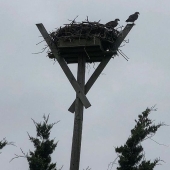Interesting thread on raptors, thanks all.
I have a few comments regarding nest boxes for at least the ones in my local area (Gulf Islands of BC).
In my immediate vicinity, I see or hear routinely Bald Eagles, Osprey, Sharp-shinned and Cooper's hawks, occasionally Red-tailed hawks too. Turkey vultures live here too in large numbers for much of the year, sometimes returning from the south as early as January or February these days. They're very secretive with nest sites, but they seem to use secluded ledges on the steep rock cliff that runs through my forested ridgetop land, well away from danger of dogs or humans. And as was said previously, turkey vultures are not raptors.
The eagles need really big trees (Douglas-fir locally) since their nests can exceed a ton or more in weight. The Sharp-shinned hawk that's been here a long while is presumably nesting at ground level on a rocky bald, since I see it take off when disturbed by human presence.
With the arrival here some years back of capable, aggressive and prolific Barred owls, the populations of the smaller owls have taken quite a hit. Western Screech owls were widespread but have become a rarity, as too for Saw-whet owls. The latest increase in owl numbers has been in Great Horned owls, now with so many to be heard after dusk on winter nights that I recently recorded five individuals calling to advertise their occupancy all at the same time - two mated couples and a single male seeking a mate. They were all within just a few hundred yards of each other, as I captured their calls from outside my front door. They will tackle any prey available including all the smaller owls, cottontails, even sick fawns and raccoons. Mostly their focus is on rodents though.
A local favourite is the Northern Pygmy owl, who despite their diminutive size, will haul away fat mice and small birds (juncos etc) grabbed near a seed feeder. They are remarkable hunters (in daylight too) and quite fearless, even around humans. In the case of the Pygmy owls, it seems the best way to support them is with a well-fed junco population, since they are probably the commonest species here for much of the year. A couple of Pygmy owl boxes are waiting for me to find the right, out-of-the-way locations to be installed on trees. Don't underestimate though, the challenge of getting any but the smallest of nest-boxes up and well positioned safely into a tree location. Take it slowly and plan which hand is going to be free to do what, especially when working on a tall ladder.
Since Great Horned owls are no doubt less common elsewhere, maybe in your area a nest site can be provided this way : Find a large deciduous tree such as a spreading maple etc (maybe multi-stemmed) and create a shallow triangular platform supported between three of the stems. This 'platform' is just to carry the considerable weight of branches, leaves and moss the owls themselves will bring to the platform once they discover it. You can help start them off by putting a small amount there just to disguise the platform once completed.
If you use a wire mesh base such as 2" stucco wire attached to cable, strong wire or such along the edges, between the tree-stems, you'll need to find a way to prevent long-term damage to the tree by using stainless steel screws etc., not galvanised or plated. Otherwise you'll kill the tree eventually. It should be like a shallow saucer to support the natural materials.
The platform must be well-supported since it may be used over many seasons, and they'll bring in much material which, when wet will be a heavier load. Needs to be installed between 15 and 45 feet up in the tree.
The Barn owl needs all the help it can get, as safe and dry nest sites are ever harder to find for them. If you live in meadow or rough pasture areas that have good populations of voles or mice, then it likely is or was Barn owl habitat, and could be so once again. A good Barn owl nest-box design is here:
https://fraservalleyconservancy.ca/wp-content/uploads/2022/05/How-to-build-and-install-barn-owl-nest-box.pdf
The Barred owl though has been such a disaster for the survival of the smaller and less 'hungry' owl species, that I'd suggest instead focussing on good, predator-proof nest-box construction & installation solely for birds, such as the smaller owls, that really need it. Where I live, Barred owls are more or less an invasive species, out-competing all but the Great Horned, and both of them significantly reducing other types of owl.
To help raptors in your own specific area, it's better to get reliable info from local/regional or national conservancy organisations on which species are in decline and need a hand, rather than relying on a "woodworker crafts" organisation for their suggested projects. Information too, on what actually works for the birds themselves - adults and young - has greatly improved the designs of nest boxes in recent years, so both the recommended dimensions as well as other features have changed in the past few years. Particularly, techniques for reducing predation by larger species on smaller ones have greatly improved, with appropriate opening sizes and small baffles included to prevent access to the nestlings by predators. It's certainly worth the time to research raptors' needs, before starting cutting the wood.
Both Audubon Society and Cornell ornithology dept. (Cornell Bird Lab? maybe..?) have excellent resources worth checking out.
Also allaboutbirds.org
And of course, particularly for the nocturnal raptors, enjoy spending some time outside under dark skies just standing quietly to listen to what owls are in your region - you may be surprised at how many different calls can be heard. With their phenomenal hearing and vision, they may know very well that you are present, before you know they are, so be as quiet as possible, and patient. Winter through spring are often good times, as many owls start establishing their breeding territory quite early, and so the pair often call together to tell other individuals to space their chosen territory far enough away. None of them are looking for conflict necessarily - just looking for each to have their own space without disputes. They already have a big enough task raising their brood, without needing additional hassle from encroachments and conflict.
Merlin, a free bird ID app for Sound ID as well as visual identification, is a great resource that will help you know which species are living around you.
https://merlin.allaboutbirds.org/sound-id/
All kinds of species really benefit from big older snags and dying trees being retained and left to fall by themselves in their own good time, if they're not actually hazardous to people or property. For wildlife a dead tree is often more valuable than a live one, and so many of them get cut down for no good reason that birds, red squirrels and a thousand other species who depend on dead/dying trees for nesting-habitat and food are getting severely depleted unnecessarily.
Hope this helps.







